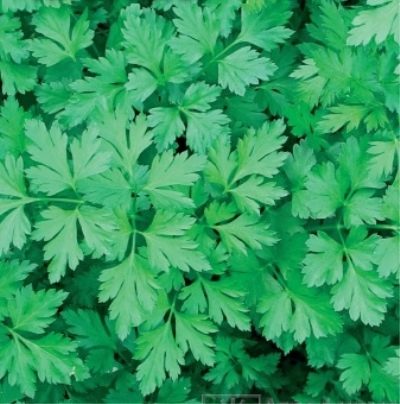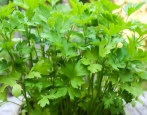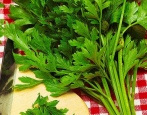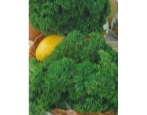
- Year of approval: 1950
- View: sheet
- Leaves length: medium
- Leaf color: dark green
- Leaf shape: narrow triangular
- Edge waviness: strong
- Petiole: middle length
- Petiole thickness: medium
- Petiole coloration: no anthocyanin
- Weight of one green plant, g: 77
Among the many types of greens that are used in the preparation of various salads, hot and cold dishes, parsley occupies a special place. It is easy to grow a vitamin vegetable if you choose a fruitful and easy-to-care variety. These are the early ripening parsley Ordinary leafy, bred many years ago.
Breeding history
Common parsley leaf is a culture with a long history, bred in 1949. In 1950, the variety was entered into the State Register of Breeding Achievements of the Russian Federation. Greens can be cultivated in all climatic zones of the country.
Description of the variety
This variety is a rather voluminous plant with a semi-vertical foliage rosette, consisting of a huge number of leaves - from 40 to 100. The plant is characterized by an average height of 35-50 cm, abundant thickening of dark green narrow-triangular leaves with strongly wavy ends, as well as thickened and an elongated petiole of light color without anthocyanin.
During the flowering period, an umbrella with light or milky greenish flowers is formed on the bush. At the end of flowering, seeds appear. If there is no need for seeds, then it is better to cut the umbrellas, since they take a lot of energy from the plant, and the leaves become stiff and dry.
Appearance
Common parsley is characterized by a powerful leafy crown. The greens of the vegetable have increased meatiness, juiciness, and also excellent taste. On average, the weight of one bush is 70-77 grams. The seeds of parsley are medium-sized, brown in color. A huge advantage of the variety is the rapid growth of greens after cutting.
It is recommended to store cut greens in the refrigerator in a film. As a rule, the vegetable retains its appearance and nutritional value for several weeks. Frozen parsley has the longest keeping quality. It is necessary to transport greens very carefully so that the stems do not break and the leaves do not crumble.
Purpose and taste
This variety is famous for its excellent taste. The leaf rosette is very juicy, fleshy, with a pronounced gloss. The vegetable has an unusual taste - a bright spice goes well with piquant notes and a sweetish aftertaste. Parsley leaves contain an increased amount of essential oils, beta-carotene, retinol, vitamins B, C, K, as well as minerals (selenium, phosphorus, potassium and calcium).
Cut parsley is widely used in cooking - it is eaten fresh, added to salads, hot and cold dishes, decorated with sandwiches, and also dried and frozen. In addition, parsley is often used in traditional medicine.
Ripening terms
The variety is early maturing. From the moment of emergence of seedlings to the technical ripeness of a vegetable crop, 65-75 days pass. The first cut can be done when the bushes grow 15-20 cm. Harvesting occurs in July-September.
Yield
The variety belongs to highly productive species. The yield indicator depends on the cultivation method.When grown on a garden ridge, you can make up to 4 cuts and get an average of 2.6-2.8 kg of greens from 1 m2 of plantings. When grown year-round, it is possible to perform up to 8 cuts and get 5-6 kg of vitamin greens.
Growing and care
Growing parsley is possible on the garden ridge, and in greenhouse conditions, and even on the kitchen windowsill. Greens are cultivated through sowing seeds. In open ground, seeds are sown from April 20 to May 10. To do this, grooves with a depth of 1-2 cm are made on the ridge, keeping a distance between them of at least 20 cm. The recommended scheme for sowing is considered to be a scheme of 10-15x30 cm.After sowing, the plantings are covered with a film, opening it daily for half an hour for airing. The film shelter will protect against sudden recurrent night frosts, and also accelerate the process of emergence.
Caring for parsley consists of basic measures: regular irrigation with settled water, fertilizing twice a season (potash and superphosphate complexes), loosening the soil after each watering, weeding row spacings, which will prevent the appearance of weeds, mulching with humus, thinning the beds, which contributes to an increase in size bushes.
Soil requirements
For parsley, a site is selected with a loose, light, fertilized, moist and breathable soil, which has a low or neutral acidity. Often these are sandy loam or black soil.
Required climatic conditions
Despite the fact that Ordinary leaf parsley is a cold-resistant and shade-tolerant culture, it is recommended to plant it in sunny, light, warm beds, protected from drafts and excess water accumulation.
Disease and pest resistance
The immune defense of parsley is average, so it is important to follow agrotechnical recommendations. Rust, white rot, downy mildew and cercosporosis are considered dangerous for the plant. It is extremely rare that parsley is attacked by melon aphids, carrot flies and stem nematodes.







































